The Evolution of Emerson Pride: Part 1
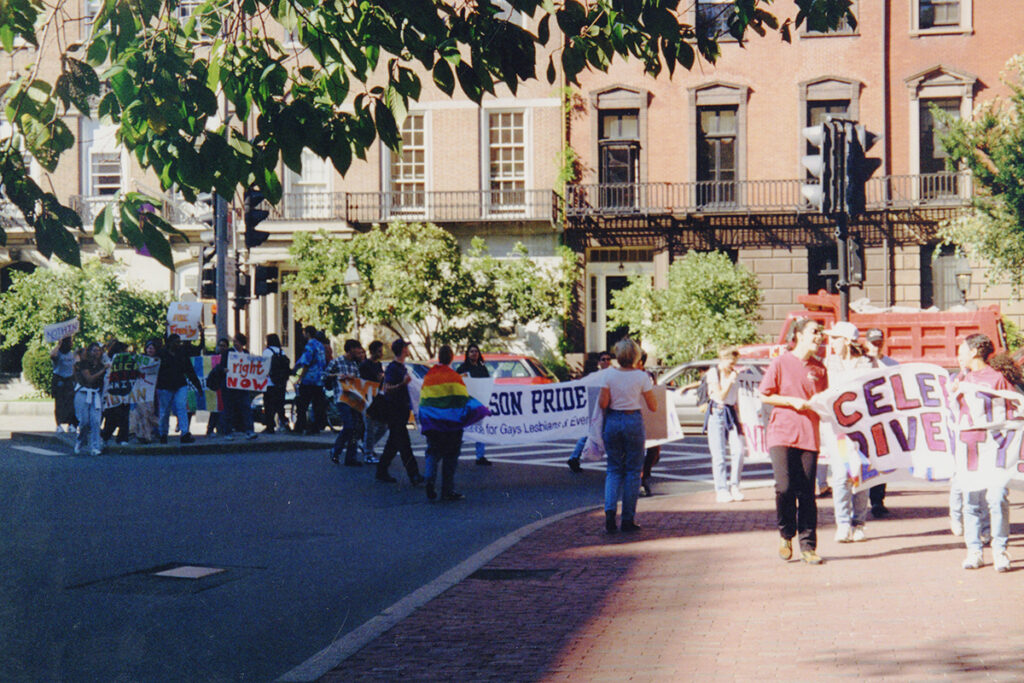
First in a two-part series
Emerson is well known today as a welcoming place for LGBTQIA+ people, but how did we get here? How can revisiting our past help us understand what progress still needs to be made?
Using resources compiled by Emerson Archives & Special Collections Assistant Director Jennifer Williams and archivists Michelle Romero and Melissa DiBerardino, as well as Emerson Today records, we’ve built a timeline of LGBTQIA+ life at Emerson spanning the past 50 years.
Disclaimer: This timeline does not claim or attempt to be comprehensive, merely a series of snapshots across the decades that illustrate the ways the LGBTQIA+ community has taken its place on campus.
The majority of information provided by the Archives comes from Berkeley Beacon articles. Photos, with few exceptions, are from Emersonian yearbooks or Emerson Today. Large gaps in information pertaining to LGBTQIA+ issues/events exist in the records. Terminology is reflective of its time.
1970s
November 1, 1972: The first meeting of the Emerson Homophile Arts Society, “a group of Emerson students who, through their own creative abilities, will work in the communication arts towards the understanding and acceptance of gay life,” is held, according to a listing in the Berkeley Beacon.
“Emerson has always had a large gay population, however there has never been an outlet for us. We are forced to either live our lives away from school or play the games of straight society. It’s time for the Emerson gay community to come out of its closet. The Emerson Homophile Arts Society offers a creative and social outlet that will unite gay people on campus.”
A local gay activist invited to attend “noted favorably” that nearly half of the group were women, because “most [gay] groups are run by and for males,” but she urged the Emerson group to get politically involved. “She seemed disillusioned at the mediocre efforts of other campus homophile organizations in Boston,” the Beacon wrote.
One student in attendance stresses that it’s important that Society members “maintain a pleasantly positive attitude when being identified as homosexuals.” The group’s faculty advisor makes clear that faculty and administration would need to be reassured that “they would not be ‘liberated,’” in part to appease those “who balked at the thought of a homosexual organization at Emerson.”
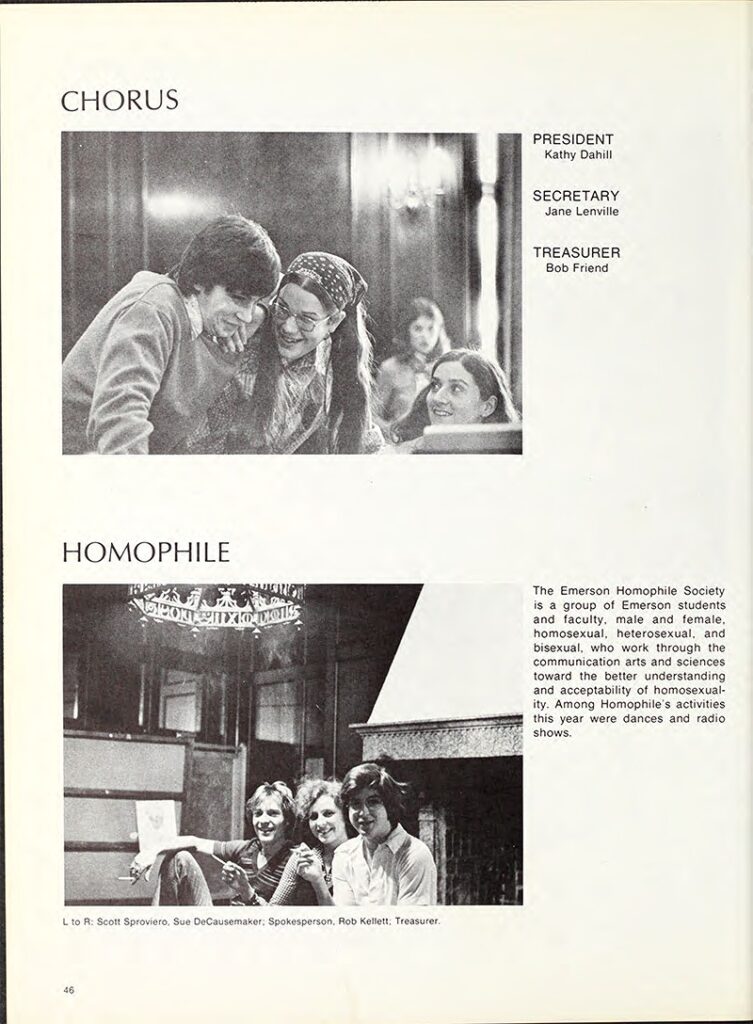
March 1973: The Emerson Homophile Arts Society sponsors the New England Regional Gay Conference, welcoming participants and organizations from across New England, as well as New York and New Jersey. The purpose of the gathering was to take stock of the gay community and its place in society, and to organize in an effort to move forward. The event offered workshops on Law Reform, Counseling, Religion, and Education through the Arts and Media, as well as a Women’s Caucus that focused on issues specific to lesbians.
The week prior, the Massachusetts House of Representatives Judiciary Committee held a hearing, reported on by the Beacon, on a bill that would repeal ancient, discriminatory, and unequally enforced sex laws, in the commonwealth. Elaine Noble, Homophile Arts Society advisor and co-director of the Massachusetts Women’s Political Caucus, spoke in support of the bill by quoting statistics from the Kinsey Report that “[caused] the members of the Judiciary Committee to squirm a bit,” the Beacon reported. “There was no opposition organized against the repeal of the sex laws, but it seems the changing of these statutes in Massachusetts is still years away.”
(Editor’s note: While enforcement of those laws was limited by the Supreme Judicial Court in 2002, those laws technically are still on the books in 2022.)
September 26, 1973: EHAS participates in “Gay American Day,” where students take tours of the State House and learn to lobby and advocate.
April 1974: In a piece in the Beacon, a student writing on behalf of the Homophile Arts Society acknowledges that the group has struggled with apathy on campus, but called the New England Regional Gay Conference a success that “strengthened gays both as groups and as individuals. With this strength, we are reaching out to touch more of our silent numbers.”
November 1974: After struggling to secure a budget or an advisor, and following a gradual decline in interest, Homophile Arts Society coordinator Barton Rouse sets out to reenergize the group. “All precedents have been thrown out the window and we now look to our people to find out what needs to be done.” Suggestions included a Thanksgiving dance, a Berkshires retreat, a performance, speakers, and a regular radio show or campus publication.
November 1975: The Homophile Arts Society hosts a Gay Alternatives in Boston panel, to let students know about gay-focused activities and services available to them beyond gay bars.
October 1976: The Beacon reports that despite anti-gay slurs and death threats left on desktops and bathroom walls around campus, Emerson’s gay community “continues to thrive,” and the freshmen class contains a number of gay students, bringing “new vitality” to the community. Homophile Happening, a gay public affairs program on WERS, launches its second season.
December 1977: The Homophile Society sponsors a course on “Coming Out” for Emerson students. “At the beginning of the year, Homophile recognized a need for the college to offer its gay students some type of discussion group on sexual issues. Since then there are a number of gay students in the dormitories who said they are experiencing problems with straight roommates. Becoming exposed to the course would be of great value to them.”
January 1979: A four-day series of panels around sexuality, organized by Emerson’s psychological counselor, features one session on “Homosexuality: Gay or Straight?” Speakers are Dr. Bianca Murphy, counselor for the Women’s Interest Society, and gay organizer and Harvard doctoral candidate Joseph Interante.
1980s
March 1981: An advertisement in the Beacon titled “Straight Gay Students,” seeks the “regular-type guy” who wants to meet other gay men but dislikes the bar scene. Meets at MIT.
December 1985: The Beacon advertises a Women’s Support Group for “Emerson’s bisexuals, lesbians, and other interested parties,” part of Boston’s Intercollegiate Lesbian and Gay Association.
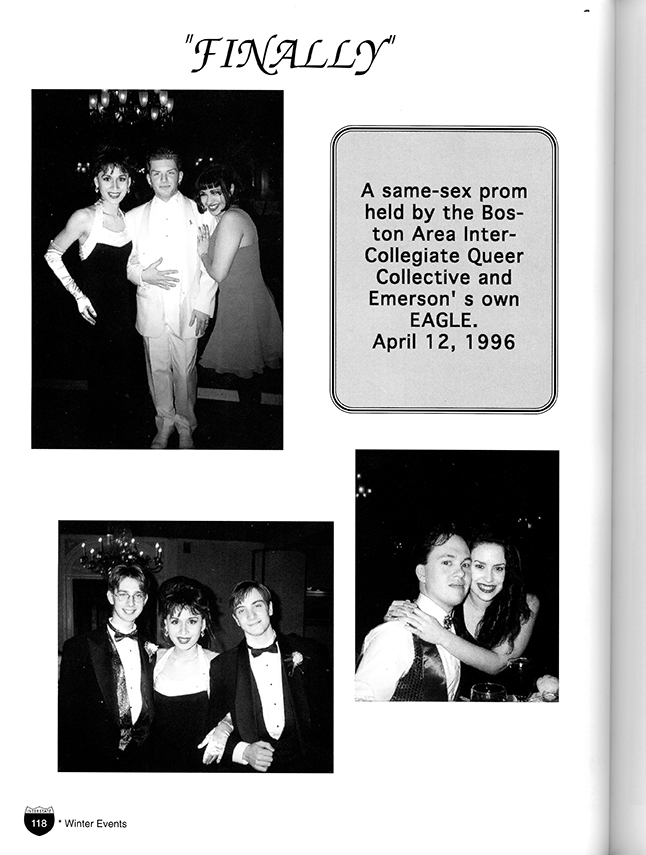
April 1986: A newly formed Emerson Gay Men’s Group announces a meeting. Emerson’s Lesbian and Bisexual Alliance hold a meeting.
March 1987: The Beacon publishes a Page 1 article about AIDS, how it’s contracted and prevented, and symptoms, while refuting the common misconception that it’s an exclusively gay disease. “This is a very dangerous view, for it at once gives a false hint of safety to the heterosexual community, while also adding to the homophobia in our society,” the Beacon reports. The article was prompted by a February 19 letter to the Beacon from WBZ-TV journalist Jeanne Blake, pleading with students to practice safe sex.
December 1988: The Beacon profiles an anonymous gay art student in Boston, and talks to him about his experience coming out in high school, his hopes for a relationship, and life as a gay college student. “I’d rather say that I was an artist … I am a ‘guy-who-is-gay,’ as you are a ‘guy-who-is-straight.’” he told the reporter. “But that’s not how I want to be known. I’m other things first.” The story also highlights the Gay Community Health Center in Boston, which specializes in psychological services for gay residents.
1990s
April 1990: A group of primarily straight students, inspired by Warren J. Blumenfeld’s Looking at Gay and Lesbian Life, poses as gay couples at Cityplace, a food court at the corner of Boylston and Charles street, in an experiment designed to gauge discrimination. The “couples” hold hands and display affection while they and other students take note of how they are treated. The “lesbian” couple reports being laughed at by workers and customers at a yogurt shop, while the “gay” couple says they were harassed by security guards, who told them to stop holding hands because they were “offending … families,” tried to prevent them from taking the escalator to the second floor, and followed them to the door of the mall when they left. “The experiment was unnerving for many of the students.”
Fall 1990: The Boston chapter of Queer Nation holds its first “Stop the Hate” march in Boston’s South End. The march is intended to make the queer community visible and to protest hate and violence directed against them. Outside the Boston Public Library, an anti-gay protester throws a bottle at the Stop the Hate marcher, and is arrested. Some Emerson students participate in the march, though one straight ally laments that there weren’t more.
In a letter to the Beacon, one student who self-identifies as gay takes offense to the term “queer,” and wonders where the gay and lesbian faculty are at Emerson. In response, a group of gay and lesbian faculty write that they have been meeting bimonthly at the Newbury Street Souper Salad, and invite any gay or lesbian community members to join them. They’d be at the table with the Gay Community News visible.
December 1990: The Emerson Gay, Lesbian, and Bisexual Alliance announces its formation. The primary goal of the group, according to founders James Dwyer and Ken Feil (Andrew Scott was another), is to offer LGBTQ students “personal and group identity, affirmation, and pride.” “[T]oo often we assume that our sexuality is an individual matter. Yet, this denies the vast history of lesbian and gay experience, as well as the construction of lesbian and gay communities since the 1960s”
Spring 1991: First mention of GAE (Gay at Emerson). (Editor’s Note: It’s not clear from the record if this is a new name for the GLB Alliance or a separate org. There appears to be no future reference to the GLB Alliance.) “We needed a safe and supportive place for people to explore and feel comfortable with their sexuality,” student Jackson Holtz says. There is some concern at the first meeting that the name of the group alienates women, but they decide to stick with it. By National Coming Out Day of that year (October 12), there are 40 active members in the group.
October 1991: GAE lodges a complaint against Rho Delta Omega fraternity over a pledge song that GAE feels contains a homophobic verse. RDO rejects the claim that the song was homophobic; the matter is taken to the newly formed Multicultural Alliance, of which GAE is a member.
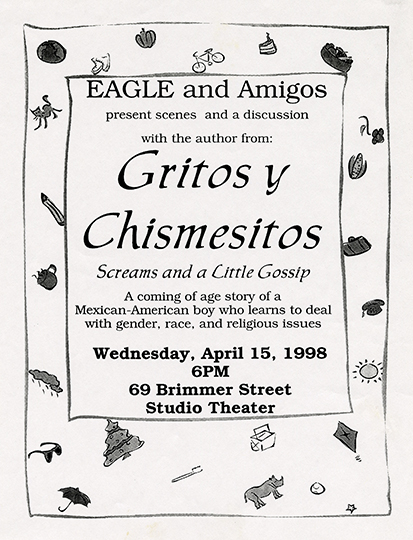
Fall 1992: GAE becomes EAGLE (Emerson’s Alliance of Gays, Lesbians, and Everyone Else) and receives SGA funding for the first time. New president David Valdes says he hopes to see the org, with about 50 members, become a “strong force” on campus. “We’re trying hard to be a good social outlet on campus that is also a channel for activism,” he said. In addition to social and fundraising activities planned for the year, the group plans to promote “coming out-packets,” with resources for students.
Spring 1995: EAGLE has lost its funding and is in danger of not being recognized the following year.
October 1995: EAGLE, now an org “in name only” launches its reorganization push with a Coming Out Day soiree, in conjunction with CAPE (Committee for Awareness Programs at Emerson), who is offering a roundtable discussion of coming out stories. As the Supreme Court prepares to release an opinion on Colorado’s Amendment Two, which prohibits anti-discrimination laws to protect gay, lesbian, and bisexual people, Co-Advisor David Valdes-Greenwood said “We can’t be apathetic to the gay community.”
November 1995: EAGLE, CAPE, and other campus groups commemorate World AIDS Day with a film screening, a paper AIDS quilt, personal reflection, and a candlelight vigil among other events.
Spring 1996: EAGLE once again plans a renaissance, this time under new president Steve Lozier. In a Beacon article, Lozier theorizes about the College’s difficulty in maintaining an active GLB affinity group.
At some colleges and universities, gay organizational meetings are sometimes the only place students can come together and be open, he said. “At Emerson, you pretty much have that environment all day long, for the most part. I think [Emerson students] take that for granted.”
The Women’s Network, an offshoot of EAGLE catering to lesbians and bisexual women, launches.
April 1996: EAGLE is awarded an Honorable Mention for Student Organization of the Year at Hand Me Down Night, a precursor to the ERA Awards.
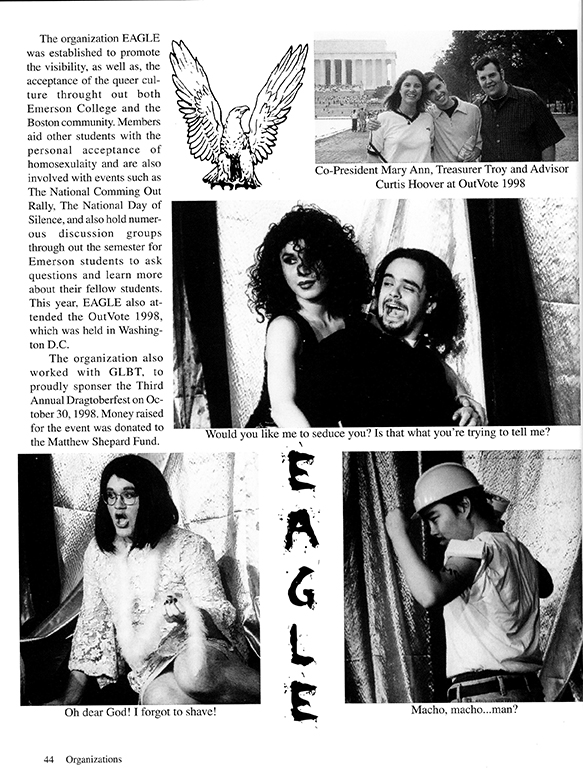
October 1996: EAGLE’s co-president speaks about cultural isolation and lack of understanding at a diversity march led by AMIGOS in response to a racial slur posted on a student’s door in the Little Building. EAGLE also sponsors its first Dragtoberfest, in addition to other events in support of Gay and Lesbian History Month, and enjoys a growing membership.
April 1997: EAGLE hosts The Word Is … OUT, a showcase highlighting visual and performing art of the gay, lesbian, and bisexual community. The exhibition features film, video, literature, and visual arts by GLB artists or that address GLB themes, as well two performances: Will Harell’s Suds and Beauty Is Only Skin Deep … A Drathology. EAGLE is awarded SGA office space for the first time.
Fall 1997: The newly created position of Coordinator of Gay, Lesbian, and Bisexual (GLB) Student Life, serves as advisor to both EAGLE and the Women’s Network.
April 1998: Emerson students attend the Sound Mind, Sound Body, Sound Off conference on gay, lesbian, and bisexual issues at Tufts University. The conference, co-sponsored by Tufts, the Governor’s Commission for Gay and Lesbian Youth, and the Massachusetts Department of Public Health, is the first of its kind in the country to be sponsored by government agencies, according to the Beacon. Emerson students first participate in the National Day of Silence Project to acknowledge the oppression that GLB people face.
Fall 1998: Homophobic graffiti scrawled on a student’s whiteboard in the Little Building sparks an outcry on campus. EAGLE officers travel to Washington, D.C. to attend the OutVote ’98 conference, the largest GLB political convention in the country.
EAGLE makes the first apparent reference to trans people in the Beacon.
Up Next: Part 2, Covering the 2000s to today.
Care about Emerson Pride? Learn how you can support current and future LGBTQIA+ students at Emerson Pride 2022.
Categories